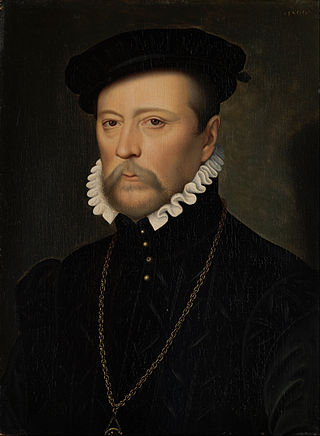
The French Wars of Religion were a series of civil wars between French Catholics and Protestants from 1562 to 1598. Between two and four million people died from violence, famine or disease directly caused by the conflict, and it severely damaged the power of the French monarchy. One of its most notorious episodes was the St. Bartholomew's Day massacre in 1572. The fighting ended with a compromise in 1598, when Henry of Navarre, who had converted to Catholicism in 1593, was proclaimed King Henry IV of France and issued the Edict of Nantes, which granted substantial rights and freedoms to the Huguenots. However, Catholics continued to disapprove of Protestants and of Henry, and his assassination in 1610 triggered a fresh round of Huguenot rebellions in the 1620s.

Charles de Lorraine, Duke of Chevreuse, was a French Cardinal, a member of the powerful House of Guise. He was known at first as the Cardinal of Guise, and then as the second Cardinal of Lorraine, after the death of his uncle, Jean, Cardinal of Lorraine (1550). He was the protector of François Rabelais and Pierre de Ronsard and founded Reims University. He is sometimes known as the Cardinal de Lorraine.

Jacques Grévin was a French playwright.
David XI or Dāwūd Khan II was king (mepe) of Kartli. A convert to Islam, he was appointed as Khan of Kartli by the Persian Shah Tahmasp I from 1562 to 1578.

The Battle of Coutras, fought on 20 October 1587, was a major engagement in the French Religious Wars between a Huguenot (Protestant) army under Henry of Navarre and a royalist army led by Anne, Duke of Joyeuse. Henry of Navarre was victorious, and Joyeuse was killed while attempting to surrender.

John VIII de Bourbon was Count of Vendôme from 1446 until his death. A member of the House of Bourbon, he was the son and successor of Louis, Count of Vendôme. As a courtier of King Charles VII of France, he fought the English in Normandy and Guyenne. He attached himself to King Louis XI, but was not in royal favor. He withdrew to the Château of Lavardin and completed its construction.

The Gardes du Corps du Roi was the senior formation of the King of France's household cavalry within the maison militaire du roi de France.

Pierre Dupuy, otherwise known as Puteanus, was a French scholar, the son of the humanist and bibliophile Claude Dupuy.

Odet de Coligny was a French aristocrat, cardinal, Bishop-elect of Beauvais, Peer of France, and member of the French Royal Council. From 1534 he was usually referred to as the Cardinal of Châtillon.

Ambel is a commune in the Isère department in the Auvergne-Rhône-Alpes region of southeastern France.
Louis de Bourbon styled as the Prince of La Roche-sur-Yon was born in 1473. He was the son of John II, Count of Vendôme and Isabel de Beauveau. He married his cousin, Louise de Bourbon, Duchess of Montpensier, eldest daughter of Gilbert of Bourbon, Count of Montpensier and Clara Gonzaga, on 21 March 1504, by whom he had three children. He died in 1520.

Gentian Hervetus (Hervet) was a French Roman Catholic theologian, humanist and controversialist.

François de Scépeaux de Vieilleville, lord of Vieilleville, 1st comte of Durtal, was a French governor, diplomat, ambassador, conseillé du roi and marshal. During his career, he would serve four French kings. He fought throughout the later years of the Italian Wars, acquiring for himself the key frontier governorship of Metz in 1553. Under King Charles IX he would be elevated to marshal and would serve the crown in the early religious wars, increasingly in the role of peacemaker and diplomat, though with scattered military service as with the recapture of Le Havre in 1563. He died in 1571, shortly before France would be shaken by the St Bartholomew's Day Massacre.
Jean du Tillet was a French Catholic bishop.
Jean de Serres was a major French historian and an advisor to King Henry IV during the Wars of Religion that marred the French Reformation in the second half of the Sixteenth Century. As a refugee from religious persecution, he was educated in Switzerland and became a Calvinist pastor, humanist, poet, polemicist, and diplomat. His complete translation of Plato appeared in the famous 1578 edition published by Henri Estienne, which is the source of the standard 'Stephanus numbers' still used by scholars to refer to Plato's works. In 1596, de Serres was appointed 'Historian of France' by King Henry IV. His posthumously published History of France was an 'immense success' and was not superseded for almost a century.
Pierre Billard was a French journalist, film critic and historian of cinema.

Isabelle de Beauvau or Isabeau de Beauvau was a French noblewoman, of the Beauvau family, lady of Champigny and de la Roche-sur-Yon, countess of Vendôme by her marriage.

Louis de Beauvau, lord of Beauvau and Sermaise in Anjou. He was ambassador to Henry VI of England, retainer of the House of Anjou, and close friend of René of Anjou, he was made a knight of the Ordre du Croissant in 1448. On his final diplomatic mission in 1472 to Rome for René, he died.

Jean II Babou was a French soldier, notable as grand-bailiff (grand-bailli) of Touraine and France's Grand Master of Artillery (1567). He was Lord of La Bourdaisière, count of Sagonne, Lord of Thuisseau, Chissé, Vouillon, Pruniers, Germigny and Brain sur l'Authion.

François III, Count of La Rochefoucauld, prince of Marcillac, count of Roucy and baron of Verteuil was a French courtier and soldier, serving as gentleman-in-ordinary to the king's chamber. He was a friend of Charles de Téligny and Louise de Coligny, serving as one of the witnesses to their marriage, whilst his humour and intelligence rendered him a favourite of Henry II of France and Charles IX of France. He is also notable as one of the Protestant leaders killed in the St. Bartholomew's Day massacre.















